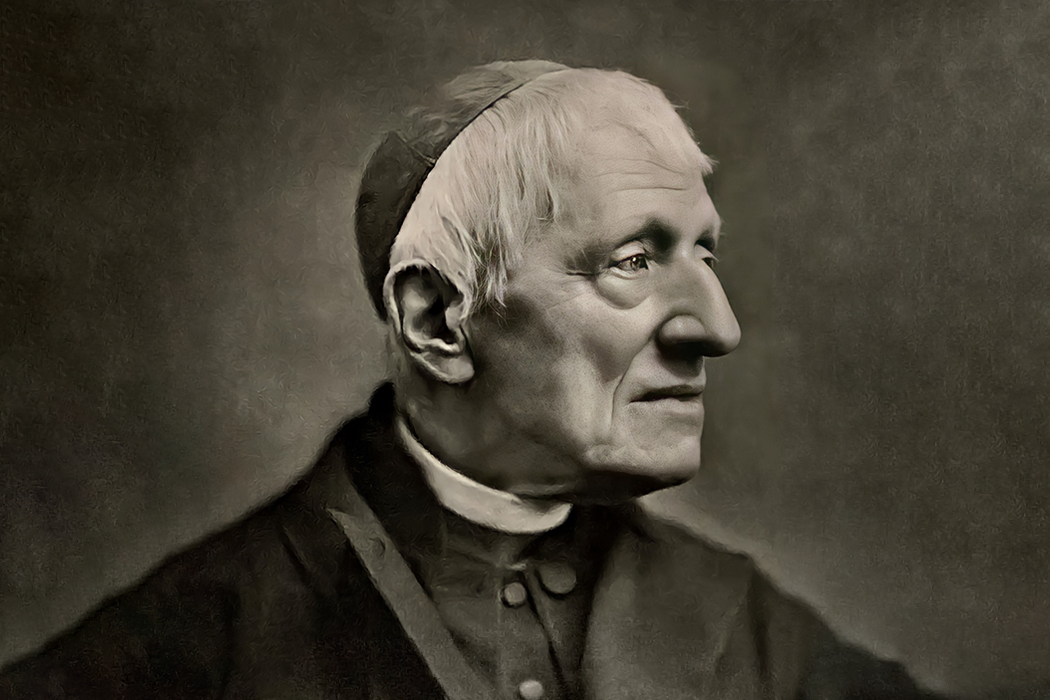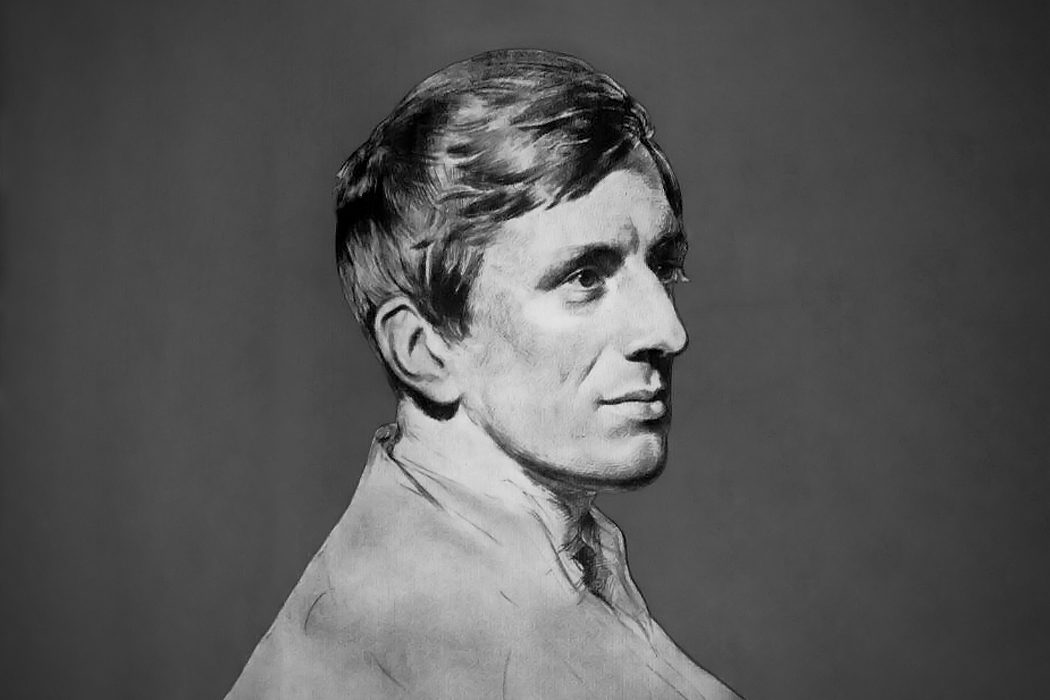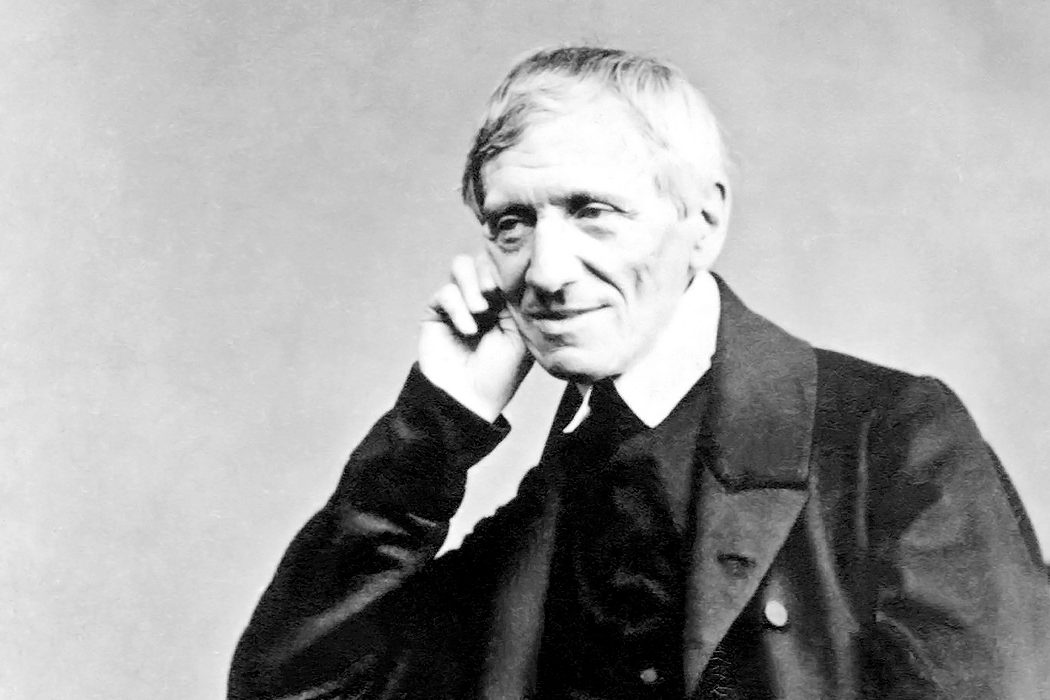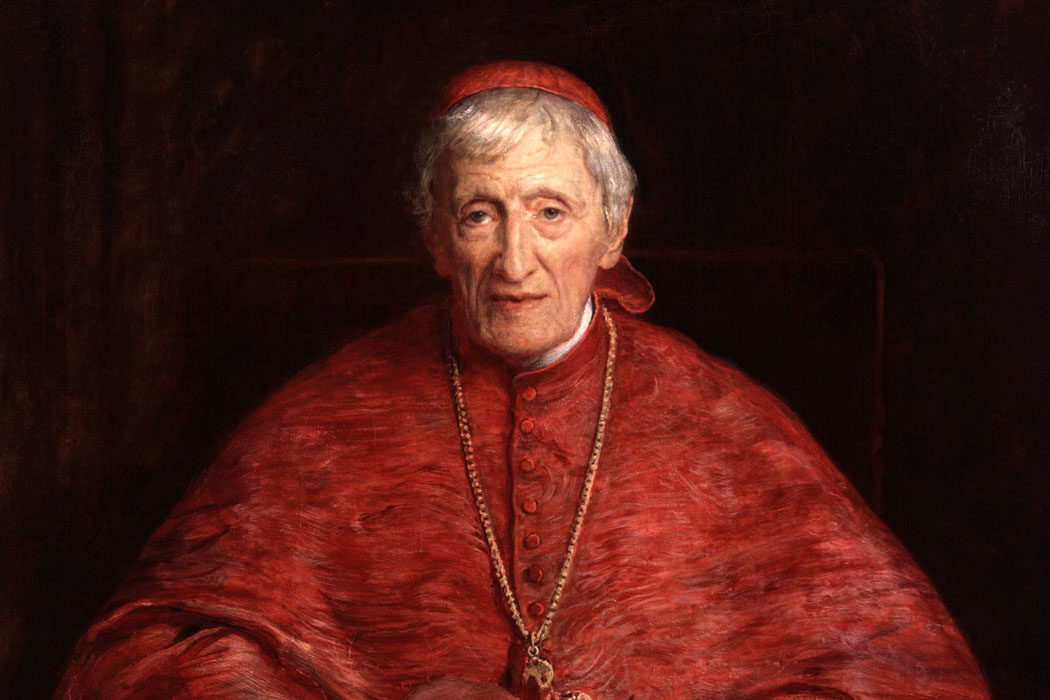
Feast Day: 9 October
Childhood
John Henry Newman was born on 21 February 1801 in London. He was the eldest of six and was the son of John and Jemima Newman. His family were practising members of the Church of England and therefore Newman was exposed to the Bible at an early age, becoming an avid reader of it.
When he was only fifteen, he would have a religious experience so strong that it would change his life forever. Writing about it later in life, he describes what happened as follows:
“When I was fifteen a great change of thought took place in me. I fell under the influences of a definite Creed… I believed that the inward conversion of which I was conscious… would last into the next life, and that I was elected to eternal glory… I believe that it had some influence on my opinions… in isolating me from the objects which surrounded me, in confirming me in my mistrust of the reality of material phenomena, and making me rest in the thought of two and two only absolute and luminously self-evident beings, myself and my creator.”
Apologia
He would go on to refer to this as his first conversion.
Around the time of this conversion experience (1816), John Henry Newman came into contact with Evangelicalism which was gaining momentum with the teaching of figures such as John Wesley. In his final year of school, Newman converted to Evangelicalism.
Life in Oxford

At the age of sixteen, Newman became an undergraduate at Trinity College, Oxford. After his undergraduate studies he was elected to a fellowship at Oriel College in 1822.
The Universities of Oxford and Cambridge were at the time part of the Anglican ‘Establishment’ and they provided the formation for Anglican clergy. Desiring to be a ‘minister of Christ’ and even wanting to take a vow of celibacy that was not common at the time, Newman pursued Anglican orders as a way of dedicating his whole life to God. He would write the day after his ordination as a deacon in 1824:
“I have the responsibility of souls on me to the day of my death.”
Autobiographical Writings, p.201
On 29 May 1825, he was ordained an Anglican priest in Christ Church Cathedral by the Bishop of Oxford and became curate of St. Clement’s Church, Oxford. In his time as curate there, Newman became known for visiting all his parishioners, especially the sick and the poor.
In 1826 Newman became a tutor at Oriel college where he began to lecture and tutor students. He took this role extremely seriously, feeling he had a religious duty to guide the young students he had been given responsibility for, to bring them to the zeal for the faith that he had discovered. However, this led the leadership of the college to accuse him of having favourites and so they refused to give Newman students from 1830 onwards.
This gave him additional time for study and here he discovered the Church Fathers, the teachers of early Christianity. Through studying them, the universal nature of the faith, and the line of apostolic succession which had preserved and transmitted it through history became clear to him. He described his reading of the Church Fathers in this way:
“Some portions of their teaching, magnificent in themselves, came like music to my inward ear, as if the response to ideas, which, with little external to encourage them, I had cherished so long.”
John Henry Newman
It was around this time that Newman was preaching at St. Mary the Virgin Church, the official Church of the University, in the heart of Oxford. Newman’s method of preaching and his messages captivated congregations. A primary source recounts, “He laid his finger gently, yet how powerfully, on some inner place in the hearer’s heart, and told him things about himself he had never known til then.”
He preached with a great understanding of the human condition whilst also commanding a great knowledge of scripture. People began to travel from far away to hear him and he quickly became the most influential preacher in the country.
Striving for renewal
In 1833 on a trip to Sicily, John Henry Newman became seriously ill and was close to death for ten days. In his delirium he repeated phrases to those aiding him, one of which was “I have a work to do in England.” When he recovered, he would consider this another great conversion as it led him to surrender himself even more to God. It awoke even more deeply his desire to bring a renewal to the Church that he loved.
On his return, Newman banded together with his friends who equally wished to bring about this renewal, namely John Keble and Edward Pusey, among others. They despaired at the state of the Church of England at that time, believing that it cared more for maintaining a good relationship with the establishment than being true to its origins and that it had been warped by its political history. Newman wrote of it, “This remarkable Church has always been utterly dependent on the civil power and has always gloried in that dependence. It would be in fact a second Reformation: – a better Reformation.“
To bring about this ‘better Reformation’ Newman and several of his associates embarked upon what would become known as the ‘Oxford Movement’, disseminating their views through a common medium: pamphlets. Titled ‘Tracts for the Times’, they challenged the status quo of the Christian establishment in England. Designed to provoke and educate, the tracts were published as the work of a nameless ‘Presbyter’, although Newman authored about one third of them. Between 1833–41 ninety tracts were published and their frequency gained the movement a second name ‘The Tractarian Movement.’
However, Newman’s best method of reaching the people was still his sermons and public lectures. The movement began to excite Christians around the country and some students at the university took up the mantra ‘Credo in Newmanum’ – ‘I believe in Newman.’
Starting to see Catholicism differently

As he continued to study and teach Christian history and especially apostolic succession, John Henry Newman began to reconsider his own hostility towards Catholicism. Catholics had been reviled and persecuted in England for centuries after the reformation, but times were changing, foremost with the passing of ‘The Roman Catholic Relief Act’ in 1829, which quelled a potential Irish revolution. Nonetheless, Newman strongly believed the Catholic Church to be lacking in holiness, writing, “Rome must change first of all her spirit, … if they (Catholics) want to convert England, let them go barefooted into our manufacturing towns, let them preach to the people, like St. Francis Xavier, let them be trampled on – and I will own that they can do what we cannot; I will confess that they are our betters.“
In Tract 90, published in 1841, Newman argued that the defining doctrines of the Church of England were in fact fundamentally more Catholic than Protestant. Many at the university felt that Newman had now gone too far; senior tutors and heads of houses expressed outrage, arguing that the message was ‘suggesting and opening a way by which men might violate their solemn engagements to the university.’ This caused the then Bishop of Oxford to call for the Tracts to come to an end. This led Newman to leave Oxford, to continue his search for the truest form of the Christian faith and to begin the next chapter of his journey.
Moving towards the Church
Increasingly struggling with the issue of apostolic succession and his changing attitudes towards Catholicism, Newman moved to Littlemore, a village three miles outside Oxford to live a quasi-monastic life with friends. Here, he continued to devote himself to ever deeper study, fasting and prayer. By 1843 he had resigned from St. Mary’s Church completely.
While at Littlemore, Newman became increasingly convinced that the Catholic Church, was the church nearest to the spirit of early Christianity. He writes:
“On the whole, all parties will agree that, of all existing systems, the present communion with Rome is the nearest approximation in fact to the Church of the Fathers … And, further, it is the nearest approach, to say the least, to the religious sentiment … of the early Church, nay, to that of the Apostles and Prophets; for all will agree so far as this, that Elijah, Jeremiah, the Baptist and St. Paul … these saintly and heroic men … are more like a Dominican preacher, or a Jesuit missionary, or a Carmelite friar … than to any individuals, or to any classes of men, that can be found in other communions.”
Essay on the Development of Christian Doctrine, pp. 97-100
However, John Henry Newman still had a significant difficulty with the Catholic Church, namely that it had seemingly added so much to the Christian faith that could not be found in early Christian history or in scripture, things like purgatory and papal supremacy. Anglican thought was that these additions were a corruption of Christian belief, but Newman wanted to probe further to examine whether these beliefs were legitimate. This led him to undertake an extensive historical study, the fruit of which would break new theological ground.
By the end of his investigation in 1845, he published one of his greatest contributions to Christian thought, the ‘Essay on the Development of Christian Doctrine’. Here, Newman explores the paradoxical idea that for an idea to remain truly itself, it must be able to change, to develop. Fundamentally, Newman came to realise that ideas and doctrines are ‘living’; they should not be considered purely intellectual beliefs or moral rules, but should vitalise the hearts of Christians and the body of the Church, just as Christ himself does. As these ideas are living things, Newman describes the idea like a creature.
“… it tries, as it were, its limbs, and proves the ground under it, and feels its way. From time to time it may fail … In time it enters upon strange territory; and old points of controversy alter their bearing… and old principles reappear under new forms. It changes with them in order to remain the same. In a higher world it is otherwise, but here below to live is to change, and to be perfect is to have changed often.”
Essay on the Development of Christian Doctrine, pp. 39-41
Symbolically, Newman’s great thesis on change comes at another great period of change in his own life, as he had arrived at the realisation that the Anglican Church could never be the church he so desired. So in that same year, he would be received into the Catholic Church.
Becoming Catholic
On 8 October 1845, Fr Dominic Barberi, an Italian, Passionist priest who was in England on missionary work, arrived at Newman’s Littlemore residence. Newman had invited him to hear his confession and to receive him into communion with the Catholic Church. By this point, many of those who lived with Newman in Littlemore had already converted.
John Henry Newman’s confession went on so late into the night that Fr Dominic insisted that they go to bed and resume it in the morning. When it was completed, John Henry Newman was received into the Catholic Church, a major step on his journey. This had huge personal consequences. By converting Newman lost most of his friends from the Church of England, his family rejected him and he could no longer be a fellow at Oxford. Newman would later describe how the trials of this period moved him to more completely surrender his life to God.
“He knows what He is about. He may take away my friends, He may throw me in among strangers, He may make me feel desolate, make my spirits sink, hide the future from me – still He knows what He is about.”
Meditations and Devotions, pp. 301-302
His conversion was accompanied by a great sense of interior peace. He wrote:
“I was not conscious to myself, on my conversion, of any change, intellectual or moral, wrought in my mind. I was not conscious of firmer faith in the fundamental truths of Revelation, or of more self-command; I had not more fervour; but it was like coming into port after a rough sea.“
Apologia, p. 238
Discovering Oratorian life
The year after his conversion, John Henry Newman was sent to Rome to further his study and here discovered the model of community life pursued by the Oratorians of St. Philip Neri. St. Philip Neri was a saint of the sixteenth century and Newman saw him as a great example of cheerful witness. He also saw in the shape of Oratorian life, something deeply familiar. He once wrote:
“The nearest approximation in fact to an Oratorian Congregation that I know… is one of the Colleges in the Anglican Universities. Take such a college, destroy the Heads’ house, annihilate wife and children, restore him to the body of fellows, and give the Head and Fellows missionary and pastoral work, and you have a Congregation of St Philip before your eyes.“
Chapter address of January/February 1848
On 1 February 1848, With the approval of Pope Pius IX, Newman established, in Birmingham, the first Oratory of St. Philip Neri in the English speaking world. The year after that, with one of his disciples, Frederick William Faber, Newman founded a second Oratory community in London. In these years, Newman began to address those who had formerly been involved in the Oxford Movement, to convince them that they belonged in the Catholic Church too. Newman’s conversion had prompted many in the intellectual spheres of Oxford and Cambridge to join the Catholic Church, but now having returned and established communities, Newman set about writing to those he had once led, encouraging them to continue seeking for the spirit of the true church. He wrote essays entitled ‘Certain Difficulties Felt by Anglicans in Catholic Teaching’ and gave a series of lectures on the ‘Present Position of Catholics in England’. However, the next phase of his journey would call him beyond his beloved England and to a new endeavour all together.
The Idea of a University
In 1852, Newman was invited to give a series of lectures in Dublin on the principles and benefits of university education. He had been invited by those who wanted to see a Catholic university founded in that city. These lectures went on to become the first parts of his next great work, ‘The Idea of a University.’ Building on his belief that ideas develop through lively dialogue, this new text was a defence of “liberal education”. He expands here:
“The University… has this object and this mission; it contemplates neither moral impression nor mechanical production; it professes to exercise the mind neither in art nor in duty; its function is intellectual culture; here it may leave its scholars, and it has done its work when it has done as much as this. It educates the intellect to reason well in all matters, to reach out towards truth, and to grasp it.”
The Idea of a University, pp.125-6
In 1854, John Henry Newman was appointed Rector of the new Catholic University of Ireland, now University College Dublin, by the Bishops of Ireland. Aiming to build it on the principles outlined in his lectures, he drew inspiration from the Catholic University of Louvain in Belgium, but also from the Oxford collegiate system with which he was so familiar. In his time as Rector, he oversaw many projects, including the construction of campus buildings, the publication of periodicals, and the recruitment of staff. He proved himself not only a strong intellectual and spiritual leader, but also a skilled manager of major projects.
Newman also wanted to counter the growing notion that being educated and cultured, being a “gentleman”, was enough to form the moral conscience. Recognising that such a view diminishes the importance of the Catholic religion in acquiring virtue, Newman wrote:
“Knowledge is one thing, virtue is another; good sense is not conscience, refinement is not humility, nor is largeness and justness of view faith. Philosophy, however enlightened, however profound, gives no command over the passions, no influential principles… It is well to be a gentleman, it is well to have a cultivated intellect, a delicate taste, a candid, equitable, dispassionate mind… but still, I repeat, they are no guarantee for sanctity or even for conscientiousness.“
The Idea of a University, pp.120-1
For four years Newman served as University Rector in Dublin but for much of this time he struggled with the role. Firstly, he was concerned for the still very newly-founded oratory in Birmingham that he was no longer able to give his time to. But he also felt under-supported and misunderstood by the Irish Bishops who had asked him to found the university. It was an extremely demanding position, obliging him to make fifty-six crossings to and from Ireland over a period of seven years. In 1858, he decided to resign as from his role as University Rector and returned to England, to his beloved community at the Birmingham Oratory.
Public attacks
The next two decades of John Henry Newman’s life brought him a series of new highs and new lows, with several controversies prompting him to write some of his best work.
The first of these controversies came when, as the editor of the Catholic Review, he was attacked by some fellow Churchmen for adopting an editorial stance seen as critical of Pope Pius IX, and for advocating that the faithful be consulted on the definition of dogmas. This led him to write a public essay on the issue clarifying himself, but because of this some bishops came to view him as problematic and one even reported him to Rome for heresy.
For the next eight years, Newman was viewed with suspicion by many in Rome. Having been disowned by the Church of England for his conversion, to then be seen as suspect by the Catholic Church, the church he had sacrificed so much to join, brought Newman to a bitter place. He would write of this time, “as a Protestant, I felt my religion dreary, but not my life – but, a Catholic, my life dreary, not my religion.” Autobiographical Writings, p. 254
The autobiography
However, another personal trial would become the catalyst for Newman’s most personal work yet, his autobiography, ‘Apologia pro vita sua’ meaning ‘A Defence of my life’. In 1864 an Anglican clergyman and Cambridge Professor wrote of Newman that he had never honestly been an Anglican. Newman felt he had to address this criticism, but that he needed to approach the challenge in a new way. What he decided to do was drastic. He decided to write his entire life’s story. He felt that he had to, “give the true key to my whole life; I must show what I am, that it may been seen what I am not, and that the phantom may be extinguished … I wish to be known as a living man, and not as a scarecrow.” Apologia pro vita sua, pp xxii-ii
For seven weeks, Newman worked himself to the point of exhaustion, writing at times for sixteen hours a day. The honesty and candidness of Newman’s five-hundred-page work led even his critics to admire his integrity; its publication did much to restore his reputation in England, amongst Anglicans and Catholics alike. In subsequent years, Newman published further works, among them ‘A Grammar of Assent’, a deep philosophical exploration of how the human person reaches convictions.
With his reputation restored, when the First Vatican Council was called in 1868, many Bishops asked John Henry Newman to serve as their expert theological adviser at the Council. Although Newman was particularly interested in the topic of Papal Infallibility, which the Council was due to discuss, he turned down these invitations in order to complete ‘The Grammar of Assent’.
Defending the faith
In 1874, Newman felt drawn to respond to an attack made on Catholics by the Prime Minister William Gladstone. Gladstone, outraged by the Vatican Council’s affirmation of papal infallibility asserted that, owing to their allegiance to the Pope, Catholics could never be loyal subjects to the Queen. Newman penned an open letter, responding to Gladstone’s contention that Catholics have ‘no mental freedom’. Newman wrote that Catholics “do not deserve this injurious reproach that we are captives and slaves of the Pope.” Not long after this, Newman would indeed find himself with much work to carry out for the Pope, as he was soon to be named a cardinal of the Church.
In 1877 Newman returned to his beloved Oxford for the first time in thirty-four years. As an indicator of how much the times had changed, he was there to receive the first honorary fellowship of Trinity College. However, in 1879, he would go on to receive an even greater honour.
Cardinal John Henry Newman

After the death of Pope Pius IX in 1878, the papacy of Pope Leo XIII began. Pope Leo admired John Henry Newman’s fierce religious orthodoxy and appointed him as a cardinal in 1879. The news that he was to be a Cardinal came as a conclusive vindication of his orthodoxy and loyalty to the Catholic Church. He himself declared “the cloud is lifted for ever.” After receiving his cardinal’s hat in Rome, Newman described how:
“… for thirty, forty, fifty years I have resisted to the best of my powers the spirit of liberalism in religion. Never did Holy Church need champions against it more than now.“
John Henry Newman
Pope Leo was so fond of Newman and his desire to stay true to the faith that he referred to him as, ‘Il mio cardinale’, meaning ‘my cardinal’.
Newman chose as his cardinal’s motto the words ‘Cor ad cor loquitur’, in English, ‘heart speaks to heart’. When he was made cardinal, Newman specifically requested not to be consecrated as a bishop (since cardinals are typically drawn from the ranks of bishops), and he asked to be allowed to remain in Birmingham. Both requests were granted and he continued to live as a cardinal, still writing, at the Birmingham Oratory.
Newman’s elevation to the cardinalate was widely lauded by his fellow countrymen. As an Anglican friend wrote to him, “I wonder if you know how much you are loved by England… by all religiously minded in England. And even the enemies of faith are softened by their feeling for you. And I wonder whether this extraordinary and unparalleled love might not be… utilized, as one means to draw together into one fold all Englishmen who believe.”
The year before he died, he would write this about the journey to sainthood:
“Such are the means which God has provided for the creation of the Saint out of the sinner; He takes him as he is, and uses him against himself: He turns his affections into another channel… it is the very triumph of His grace, that He enters into the heart of man, and persuades it, and prevails with it, while He changes it.“
Purity and Love, pp. 71-72
Death
In his final years, John Henry Newman continued to correspond with and give spiritual guidance to many. He died at the age of 89 on 11 August 1890. Tens of thousands lined the streets of Birmingham near the Oratory for the passing of his funeral cortege. He was buried in the Oratory’s cemetery. The inscription on his grave reads ‘out of shadows and symbols unto the truth.’ Newman’s journey towards the truth was complete.
This article is based on text from The Newman Canonisation >